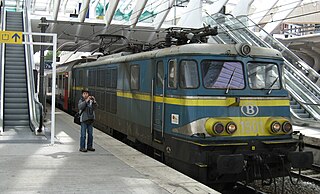Related Research Articles
The Aurora was a domestic Trans Europ Express in Italy linking Rome with Reggio di Calabria. The train was named after the Roman goddess of dawn, referring to the train's early morning departure from Rome.

The Catalan Talgo was an international express train that linked Geneva, Switzerland, with Barcelona, Spain from 1969 to 2010. It was named after the Spanish region Catalonia and the Talgo equipment it used. It was an extension and upgrading of a predecessor train, Le Catalan, a first-class-only French (SNCF) Rapide train that had been in operation since 1955 but running only between Geneva and the stations nearest the Spanish-French border, connecting with a second-class-only "autorail" trainset to and from Barcelona. The national railway network of Spain, Red Nacional de los Ferrocarriles Españoles (RENFE), was using Iberian gauge for all of its main lines, while those of France and Switzerland use standard gauge. As a result of this break-of-gauge, train journeys between Geneva and Barcelona consisted of two separate parts, with travelers having to change from a French to a Spanish train or vice versa at the border—at Portbou on southbound trains and at Cerbère on northbound trains. In 1968, this was resolved with the introduction of the Talgo III RD trainsets, which featured variable gauge wheelsets. At Portbou station, the wheel spacing of each passenger carriage was adjusted by a gauge changer for the difference in gauge, and passengers no longer had to change trains. After successful test runs, the Catalan was extended from Port Bou to Barcelona as a through train on 1 June 1969, becoming the Catalan Talgo and upgraded to a Trans Europ Express (TEE). Most other rail journeys through this border crossing continued to require a change of train at Cerbère station or at Port Bou, as most trains did not use Talgo III RD trainsets.

The Brabant was an express train that linked Gare du Nord in Paris, France, with Brussels-South in Brussels, Belgium. The train was named after the historical Duchy of Brabant of which Brussels was the capital.
The Diamant was an express train operated by the Deutsche Bundesbahn (DB), using different routes over the years. The name Diamant, Dutch for diamond, refers to the city of Antwerp, which is the European centre of diamond trade and has a diamond district. The initial service started in 1962 as a first-class-only FernTriebwagen linking the West-German capital Bonn with Antwerp, using a class DB Class VT 08 diesel multiple unit (DMU).

The Ligure was an international express train operated by the Italian Railways linking Milan with the Côte d'Azur. The train was named after the Italian region Liguria which was served by the train.

The Île de France was an international express train on the PBA route (Paris–Brussels–Amsterdam). The train was named after the French region surrounding Paris.
The Lemano was an international express train linking Milan with Geneva. The train is named after Lake Geneva, the north shore of which was followed by the train over the lake's entire length. Introduced in 1958, it was a first-class-only Trans Europ Express service until 1982, and thereafter a two-class express train.

L'Oiseau Bleu was an international express train linking Antwerp with Paris. The train was named after the play L'Oiseau Bleu as a tribute to its author, the Belgian Nobel prize laureate Maurice Maeterlinck.

The Mont Cenis was an international express train linking Lyon in France with Milan in Italy. The train was named after the mountain range through which it crossed, inside the Fréjus Rail Tunnel on the French-Italian border.
The Memling was an express train that linked Gare du Nord in Paris, France, with Brussel Zuid in Brussels, Belgium. The train was named after German painter Hans Memling.
The Rubens was an express train that linked Gare du Nord in Paris, France, with Bruxelles-Midi / Brussel-Zuid in Brussels, Belgium. The train was named after Flemish painter Peter Paul Rubens.

The Watteau was an express train that linked Gare du Nord in Paris, France, with Tourcoing in the North of France. The train was named after the French painter Antoine Watteau.

The Paris–Ruhr was an express train that linked Paris in France, with Dortmund in Germany. The train was named after its two termini, Paris in the west and the Ruhr district in the east. For most of its life, it was a Trans Europ Express (TEE).

The Rembrandt was an express train that linked Amsterdam in the Netherlands, with Munich in Germany and later Chur in Switzerland. The train was named after the renowned Dutch painter Rembrandt. For its first 16 years it was a first-class-only Trans Europ Express, becoming a two-class InterCity in 1983 and finally a EuroCity in 1987.
The Bacchus was an express train in Germany, initially linking Dortmund and Munich. The train was named after the Roman God of wine, although for most of its existence it linked two cities famous for producing beer.
The Friedrich Schiller was an express train in Germany, initially linking Düsseldorf and Stuttgart. The train was named after the philosopher and playwright Friedrich Schiller.

The Gambrinus was an express train in Germany, initially linking Munich and Kiel. The train was named after the God of Beer Gambrinus.

The Vesuvio was an express train in Italy, linking Milan and Naples. The train was named after Mount Vesuvius the volcano near Naples.

The Adriatico was an express train operated by Ferrovie dello Stato, linking Milan and Bari. It was named for the Adriatic Sea, Mare Adriatico in Italian, as the train's route served the main cities along the shore of the Adriatic between Rimini and Bari.

The Colosseum was an express train initially linking Rome and Milan, later Frankfurt am Main. The train was named after the Amphitheatrum Flavium, renowned as the Colosseum.
References
- ↑ La Légende des TEE p. 342.
- ↑ La Légende des TEE p. 343.
- ↑ Das grosse TEE Buch p. 119
